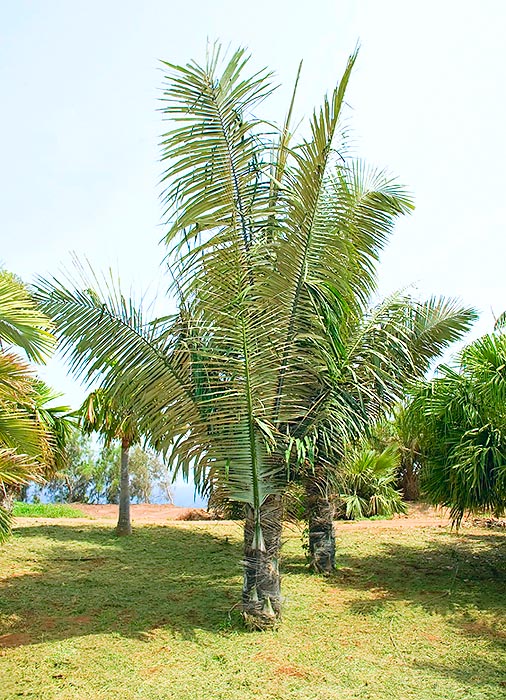Family : Arecaceae

Text © Pietro Puccio

English translation by Mario Beltramini

The leaves of Arenga pinnata can be up to 9 meters long. The sap is rich in sugar. © Giuseppe Mazza
As it happens for many plants widely cultivated since the old times, the precise place of origin of Arenga pinnata (Wurmb) Merr. (1917) is not known, it is thought to be located in the wet forests of India and Malaysia, from where it has spread all
over south-east Asia.
The name of the genus, Arenga, comes from the Malaysian name “areng”, the species Latin name, “pinnata” = feathery, refers to the appearance of the leaves.
It is commonly known as: “palma da zucchero” (Italian); “areng palm”, “black-fiber palm”, “black sugar palm”, “gomuti palm”, “sugar palm”(English); “palmier à sucre” (French); “Zuckerpalm (German); “gomuteira”, “palmeira do açucar”(Portuguese); “baru'”, “bary”, “palma de azucar”, “palmera del azucar” (Spanish).
Palm with a solitary trunk, tall up to about 12 m, and a diameter around the 40 cm, covered by the persistent bases of the leaves and by long fibres and dark thorns; the leaves are erect, long up to 8-9 m, with linear leaflets long up to 1,5 m, irregularly indented at the extremity, inserted on the rachis with various angulations; the colour is dark green on the upper side, and greyish on the lower one.
Monocarpic plant (it dies after the fructification, which lasts some years), it produces hanging, ramified inflorescences, which follow one another from the top to the bottom, and carrying either male flowers or female ones, but always on the same plant. The fruits, which take some years to ripen, are globose, 3-4 cm of diameter, usually containing three seeds, of yellow colour and are to be carefully handled, due to the presence of oxalic acid (irritant), in the pulp. The seeds germinate in 6-8 months, before, if with bottom heat.
From 2020 Arenga pinnata is inserted in the category LC, Least Concern of the Red List of the International Union for Conservation of Nature (IUCN).
The plant, still now, has a remarkable economical importance in the south eastern Asian countries, due to the sugar obtained from the sap, and its by-products, and the resistant fibres which are utilized, even if in lesser extent than in the past, for various purposes. It can be cultivated in the tropical, subtropical and even warm temperate
countries, where it can bear temperatures up to -3°C, but, then, with a remarkably slower growth.
Synonyms: Saguerus pinnatus Wurmb (1779); Saguerus gamuto Houtt. (1773); Borassus gomutus Lour. (1790); Arenga saccharifera Labill. ex DC. (1800); Gomutus rumphii Corrêa (1807); Sagus gomutus (Lour.) Perr. (1824); Gomutus saccharifer (Labill. ex DC.) Spreng. (1825); Saguerus rumphii (Corrêa) Roxb. ex Ainslie (1826); Caryota onusta Blanco (1837); Gomutus vulgaris Oken (1841); Saguerus saccharifer (Labill. ex DC.) Blume (1843); Arenga griffithii Seem. ex H.Wendl. (1878); Arenga gamuto Merr. (1914).
→ For general notions about ARECACEAE please click here.
